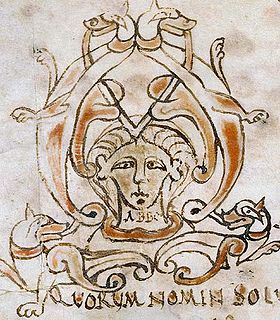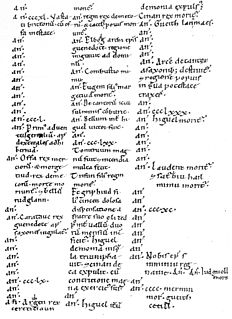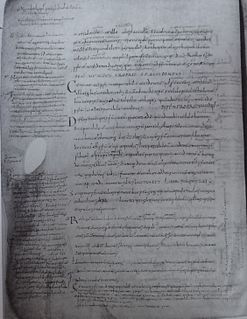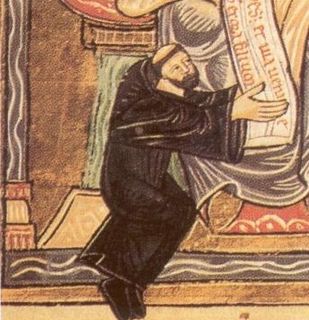 W
WAbbo or Abbon of Fleury, also known as Saint Abbo or Abbon, was a monk and abbot of Fleury Abbey in present-day Saint-Benoît-sur-Loire near Orléans, France.
 W
WAdalbert of Magdeburg, sometimes incorrectly shortened to "Albert", known as the Apostle of the Slavs, was the first Archbishop of Magdeburg and a successful missionary to the Polabian Slavs to the east of what is contemporarily Germany. He was later canonised and his liturgical feast day was assigned as 20 June.
 W
WAdso of Montier-en-Der was abbot of the Benedictine monastery of Montier-en-Der in France, and died on a pilgrimage to Jerusalem. Biographical information on Adso comes mainly from one single source and has come under question, but the traditional biography depicts him as an abbot who enacted important monastic reform, as a scholar, and as a writer of five hagiographies. His best-known work was a biography of Antichrist, titled "De ortu et tempore Antichristi", which combined exegetical and Sibylline lore. This letter became one of the best-known medieval descriptions of Antichrist, copied many times and of great influence on all later apocalyptic tradition, in part because, rather than as an exegesis of apocalyptic texts, he chose to describe Antichrist in the style of a hagiography.
 W
WÆthelstan A is the name given by historians to an unknown scribe who drafted charters, by which the king made grants of land, for King Æthelstan of England between 928 and 935. They are an important source for historians as they provide far more information than other charters of the period, showing the date and place of the grant, and having an unusually long list of witnesses, including Welsh kings and occasionally kings of Scotland and Strathclyde.
 W
WÆthelwold of Winchester was Bishop of Winchester from 963 to 984 and one of the leaders of the tenth-century monastic reform movement in Anglo-Saxon England.
 W
WAnnales Cambriae is the title given to a complex of Cambro-Latin chronicles compiled or derived from diverse sources at St David's in Dyfed, Wales. The earliest is a 12th-century presumed copy of a mid-10th century original; later editions were compiled in the 13th century. Despite the name, the Annales Cambriae record not only events in Wales, but also events in Ireland, Cornwall, England, Scotland and sometimes further afield, though the focus of the events recorded especially in the later two-thirds of the text is Wales.
 W
WJohn Canaparius was a Benedictine monk at the Aventine monastery in Rome. It had been long assumed that in the year 999 he wrote the first Vita sancti Adalberti episcopi Pragensis, or "Life of St. Adalbert of Prague" just two years after Adalbert's death.
 W
WThe Codex Vigilanus or Codex Albeldensis is an illuminated compilation of various historical documents accounting for a period extending from antiquity to the 10th century in Hispania. Among the many texts brought together by the compilers are the canons of the Visigothic Councils of Toledo, the Liber Iudiciorum, the decrees of some early popes and other patristic writings, historical narratives, various other pieces of civil and canon law, and a calendar.
 W
WThe Códice de Roda or Códice de Meyá is a medieval manuscript that represents a unique source for details of the 9th and early 10th century Kingdom of Navarre and neighbouring principalities. It is currently held in Madrid as Real Academia de la Historia cód. 78.
 W
WDagome iudex is one of the earliest historical documents relating to Poland. Although Poland is not mentioned by name, it refers to Dagome and Ote and their sons in 991, placing their land under the protection of the Apostolic See. The document's name derives from its opening words.
 W
WBorn in Gandersheim to Saxon nobles Hrotsvitha was a German secular canoness, who wrote dramas and poems during the rule of the Ottonian dynasty. Hrotsvitha lived at Gandersheim Abbey. She is considered the first female writer from the German Lands, the first female historian, the first person since antiquity to write dramas in the Latin West, and the first female poetess in Germany.
 W
WIsrael the Grammarian was one of the leading European scholars of the mid-tenth century. In the 930s, he was at the court of King Æthelstan of England (r. 924–39). After Æthelstan's death, Israel successfully sought the patronage of Archbishop Rotbert of Trier and became tutor to Bruno, later the Archbishop of Cologne. In the late 940s Israel is recorded as a bishop, and at the end of his life he was a monk at the Benedictine monastery of Saint-Maximin in Trier.
 W
WNotker Labeo, also known as Notker the German or Notker III, was a Benedictine monk and the first commentator on Aristotle active in the Middle Ages. "Labeo" means "the thick-lipped one". Later he was named Teutonicus in recognition of his services to the German language.
 W
WOdo of Cluny was the second abbot of Cluny. He enacted various reforms in the Cluniac system of France and Italy. He is venerated as a saint by the Catholic and Eastern Orthodox Churches. His feast day is 18 November.
 W
WSaint Radbod was bishop of Utrecht from 899 to 917.
 W
WRatherius or Rathier or Rather of Verona was a teacher, writer, and bishop. His difficult personality and political activities led to his becoming an exile and a wanderer.
 W
WRegino of Prüm or of Prum was a Benedictine monk, who served as abbot of Prüm (892–99) and later of Saint Martin's at Trier, and chronicler, whose Chronicon is an important source for late Carolingian history.
 W
WPope Sylvester II, originally known as Gerbert of Aurillac, was a French-born scholar and teacher who served as the bishop of Rome and ruled the Papal States from 999 to his death. He endorsed and promoted study of Arab and Greco-Roman arithmetic, mathematics, and astronomy, reintroducing to Europe the abacus and armillary sphere, which had been lost to Latin Europe since the end of the Greco-Roman era. He is said to be the first to introduce in Europe the decimal numeral system using the Hindu–Arabic numeral system.
 W
WVersus de scachis is the title given to a Medieval Latin poem about chess. It is found on two manuscripts from Einsiedeln Abbey Library, dated to about AD 1000. If this date is accurate it makes the work the earliest known reference to chess in a European text, the next younger reference to the game being in Ruodlieb, a work dated to the second quarter of the 11th century. The title of versus de scachis is from ms. 365. The text in ms. 319 is incomplete, and entitled de aleae ratione.